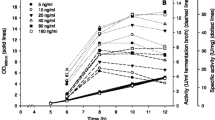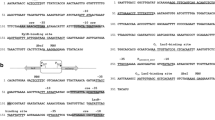Abstract
A new expression system for Lactococcus lactis was developed. The system is based on a phosphate starvation inducible pstF promoter of L. lactis MG1363. Intracellular β-galactosidase and secreted α-amylase were produced using this tightly regulated system. No evidence of regulatory sites in regions of the 5′-end of the pstF coding sequence was found. High expression levels of the β-galactosidase gene were obtained using the original pstF RBS in a phosphate-depleted medium. The results suggested that with the phosphate starvation inducible system, it is possible to achieve expression levels comparable to the ones obtained with the widely used nisin-controlled gene expression system (NICE). A specific β-galactosidase activity of 670 μkat g−1 using a phosphate-depleted medium and an α-amylase activity of 3.6 μkat l−1 in a bioreactor cultivation were produced. The advantages of the current expression system include that no prior removal of phosphate from the medium in bioreactor scale is required, and no additions of inducing agents are needed. Furthermore, the system can be operated in L. lactis without introduction of regulatory genes into the host.



Similar content being viewed by others
References
Augena M, Yagil E, Spira B (2002) Transcriptional analysis of the pst operon of Escherichia coli. Mol Genet Genomics 268:518–524
Bencini D, Wild J, O’Donovan G (1983) Linear one-step assay for the determination of orthophosphate. Anal Biochem 132:254–258
Bermúdez-Humarán LG, Corthier G, Langella P (2004) Recent advances of Lactococcus lactis as live recombinant vector for the development of new safe mucosal vaccines. Recent Res Devel Microbiol 8:147–160
de Ruyter PGGA, Kuipers OP, de Vos WM (1996) Controlled gene expression systems for Lactococcus lactis with the food-grade inducer nisin. Am Soc Microbiol 62:3662–3667
de Vos WM (1999) Gene expression systems for lactic acid bacteria. Curr Opin Microbiol 2:289–295
de Vos WM, Vaughan EE (1994) Genetics of lactose utilization in lactic acid bacteria. FEMS Microbiol Rev 15:217–237
Fitzsimons A, Hols P, Jore J, Leer RJ, O’Connel M, Delcour J (1994) Development of an amylolytic Lactobacillus plantarum silage strain expressing the Lactobacillus amylovorus a-amylase gene. Appl Environ Microbiol 60:3529–3535
Gasson MJ (1983) Plasmid complements of Streptococcus lactis NCDO 712 and other lactic streptococci after protoplast-induced curing. J Bacteriol 154:1–9
Holo H, Nes IF (1989) High-frequency transformation by electroporation of Lactococcus lactis subsp. cremoris grown with glycine in osmotically stabilized media. Appl Environ Microbiol 55:3119–3123
Jeong D-W, Choi YC, Lee JM, Kim JH, Lee J-H, Kim KH, Lee HJ (2006) Isolation and characterization of promoters from Lactococcus lactis spp. cremoris LM0230. Food Microbiol 23:82–89
Kerovuo J, von Weymarn N, Povelainen M, Auer S, Miasnikov A (2000) A new efficient expression system for Bacillus and its application to production of recombinant phytase. Biotechnol Lett 22:1311–1317
Koivula T, Sibakov M, Palva I (1991) Isolation and characterization of Lactococcus lactis subsp. lactis promoters. Am Soc Microbiol 57:333–340
Kuipers OP, de Ruyter PGGA, Kleerebezem M, de Vos WM (1998) Quorum sensing-controlled gene expression in lactic acid bacteria. J Biotechnol 64:15–21
Laemmli UK (1970) Cleavage of structural proteins during the assembly of the head of bacteriophage T4. Nature 227:680–685
Le Loir Y, Gruss A, Ehrlich SD, Langella P (1998) A nine-residue synthetic propeptide enhances secretion efficiency of heterologous proteins in Lactococcus lactis. J Bacteriol 180:1895–1903
Lindholm A, Ellmén U, Tolonen-Martikainen M, Palva A (2006) Heterologous protein secretion in Lactococcus lactis is enhanced by the Bacillus subtilis chaperone-like protein PrsA. Appl Microbiol Biotechnol 73:904–914
Liu W, Qi Y, Hulett FM (1998) Sites internal to the coding regions of phoA and pstS bind PhoP and are required for full promoter activity. Mol Microbiol 28:199–130
Madsen SM, Hindré T, Le Pennec J-P, Israelsen H, Dufour A (2005) Two acid-inducible promoters from Lactococcus lactis require the cis-acting ACiD-box and the transcription regulator RcfB. Mol Microbiol 56:735–746
Mierau I, Kleerebezem M (2005) 10 years of the nisin-controlled gene expression system (NICE) in Lactococcus lactis. Appl Microbiol Biotechnol 68:705–717
Miller JH (1972) Experiments in molecular genetics. Cold Spring Harbor Laboratory, Cold Spring, NY, pp 352–355
Narita J, Ishida S, Okano K, Kimura S, Fukuda H, Kondo A (2006) Improvement of protein production in lactic acid bacteria using 5¢-untranslated leader sequence of slpA from Lactobacillus acidophilus. Appl Genet Mol Biotechnol 73:366–373
Nouaille S, Ribeiro L, Miyoshi A, Pontes D, Le Loir Y, Oliveira S, Langella P, Azevedo V (2003) Heterologous protein production and delivery systems for Lactococcus lactis. Genet Mol Res 2:102–111
Nyyssölä A, Pihlajaniemi A, Palva A, von Weymarn N, Leisola M (2005) Production of xylitol from d-xylose by recombinant Lactococcus lactis. J Biotechnol 118:55–66
O’Connell-Motherway M, van Sinderen D, Morel-Deville F, Fitzgerald GF, Ehrlich SD, Morel P (2000) Six putative two-component regulatory systems isolated from Lactococcus lactis subsp. cremoris MG1363. Microbiol 146:935–947
Okano K, Kimura S, Narita J, Fukuda H, Kondo A (2007) Improvement in lactic acid production from starch using a-amylase-secreting Lactococcus lactis cells adapted to maltose or starch. Appl Microbiol Biotechnol 75:1007–1013
Robinson K, Chamberlain LM, Schofield KM, Wells JM, Le Page RW (1997) Oral vaccination of mice against tetanus with recombinant Lactococcus lactis. Nat Biotechnol 15:653–657
Sanders JW, Venema G, Kok J, Leenhouts K (1998) Identification of a sodium chloride-regulated promoter in Lactococcus lactis by single-copy chromosomal fusion with a reporter gene. Mol Gen Genet 257:681–685
Shin PK, Seo JH (1990) Analysis of E. coli phoA-lacZ fusion gene expression inserted into a multicopy plasmid and host cell’s chromosome. Biotech Bioeng 36:1097–1104
van Asseldonk M, de Vos W, Simons G (1993) Functional analysis of the Lactococcus lactis usp45 secretion signal in the secretion of a homologous proteinase and a heterologous α-amylase. Mol Gen Genet 240:428–434
Vershinina OA, Znamenskaya LV (2002) The Pho regulons of bacteria. Microbiol 71:497–511
Viegas SC, de Palencia F, Ambar M, Arraiano CM, López P (2004) Development of an inducible system to control and easily monitor gene expression in Lactococcus lactis. Plasmid 51:256–264
Wells JM, Wilson PW, Norton PM, Le Page RW (1993) A model system for the investigation of heterologous secretion pathways in Lactococcus lactis. Appl Environ Microbiol 59:3954–3959
Acknowledgments
We thank Valio Ltd. and Soile Tynkkynen for cooperation and for the plasmid containing the lacZ gene.
Author information
Authors and Affiliations
Corresponding author
Rights and permissions
About this article
Cite this article
Sirén, N., Salonen, K., Leisola, M. et al. A new and efficient phosphate starvation inducible expression system for Lactococcus lactis . Appl Microbiol Biotechnol 79, 803–810 (2008). https://doi.org/10.1007/s00253-008-1484-4
Received:
Revised:
Accepted:
Published:
Issue Date:
DOI: https://doi.org/10.1007/s00253-008-1484-4




